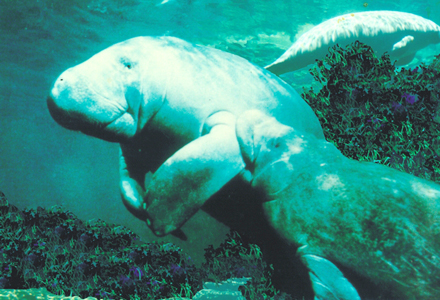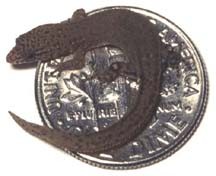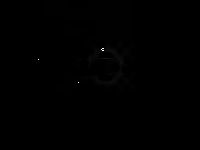Creatures of The Dominican Republic – More
Miscellaneous creatures found in Dominican Republic.
Manatee | Jaragua Sphaero | Heteropoda Venatoria/ Huntsman Spider | Noseeums (biting insects) | Hispaniola Boa/ Boa de la Hispaniola
Manatee (Trichechus Manatus)

Manatees range in color from gray to brown. Their 2 small front flippers and their flat, horizontal tails are used to move them along the sea and river bottoms. They have very small eyes and no outer ears yet they are thought to see and hear quite good. The average adult can weigh from 1,500 to 1,800 pounds and can measure ten to 12 feet in length. They can live from 50 to 60 years in the wild and much longer in captivity. They are vegetarians and are quite gentle and slow moving.
The Antillean Manatee (pictured above), a Dominican Republic native, is one precarious survivor from an insane killing from the old Spanish colonizers who believed that Manatee meat was an aphrodisiac and had the taste of seven different kinds of meats. Still in peril from the actual population, the Haitians poachers are still a major threat or this endangered species. It is a rare experience to have a close encounter with these elusive creatures, but it can happen while diving within the sanctuary.
Interesting fact: Did you know the word Manati came from the language of the original inhabitants of the island, the Taino Indians? They gave this marine animal its name. it was considered to be sacred. It is also thought that when people saw mermaids, known in Spanish as Sirens, they were really the manatee. More Taino words used today.
The Jaragua Sphaero

The Jaragua Sphaero also known as the Dwarf Gecko scientific name: Sphaerodactylus ariasae. This little lizard was discovered in 2001 by a Penn State University scientists. This little creature fits on a Dominican Peso that is about the same size as a U.S. quarter. The Jaragua Sphaero measuring 16 to 18 mm, about ¾ of an inch, from the snout to the base of the tail, is one of the world’s two smallest known reptiles. It is found in Jaragua National Park on the remote island of Beata. It feeds on insects and fruits.
Picture of an adult female Jaragua lizard from Beata Island on a U.S. dime.
Photo credit: Copyright S. Blair Hedges at http://science.psu.edu/news-and-events/2001-news/Hedges11-2001.htm
Heteropoda Venatoria, the common name is Huntsman Spider.
Also known as the Giant Crab Spider, Housekeeping Spider and Banana Spider.

This is a very common spider found in tropical and sub tropical areas throughout the world. Its leg span can reach 5 inches. I love the mask it is wearing that gives it a very fierce look. They can move very fast which also makes them a bit frightening but they are pretty much harmless, usually running away when a human approaches. They normally eat all types of insects, especially cockroaches, crickets and moths. For this reason many people do not mind this spider setting up home in their barns and sheds. They hunt on the go, usually at night, and do not spin webs attacking their prey before they even realize what happened. They can fit into tiny places because of their flat bodies.

If this spider does bite it is a little painful but not deadly or dangerous and many reports say that when they are disturbed they play dead. Some say it is bad luck to kill this spider as it helps us humans by eating all those nasty insects.
Thank you Tony for the information. There are some great spider pictures and information on the Dominican Spiders Blog.
Noseeums (No-see-ums)
in Dominican Spanish: Mayes (may-gee’s) (found near the sea) and Gegenes (found in the hills). No matter what you call them these nasty little creatures are true bloodsuckers. They are known as Punkies, Midges, Black Gnats, and Black Sandflies. (In Spanish: Moscas de Arena, Chaquistíes, Zancudos Negros). These loathsome flies come from the family Ceratopogonidae. They are teeny, tiny, biting, persistent little buggers that are, in my opinion, worse than mosquitoes. Less than ¼ inch long and can get through a normal window screen with no problem. No problem for them but big problems for their unawares meal that just may have your name on it!

Since the noseeum cannot be seen (maybe this is why they have this nickname??) and the immediate bite can’t be felt, they can make your blood a feast before you really know what’s happening. Walking along ever so innocently one can easily stir up a swarm without knowing. If you’re lucky they will swarm. In a swarm they can be seen, a dark foreboding mass. The only problem with this swarm is they can enter any open body cavity (i.e. the mouth and nose). If you happen to find yourself in a swarm I strongly suggest that you close these openings. That is unless you want to be choking on their little, bitter tasting carcasses (yes, I know the taste well). If you have been swarmed move along quickly and get out of their territory, as they don’t like to travel very far from their home. So, I say, when you see a black cloud of flying bugs coming toward you..RUN AWAY! RUN AWAY!
These blood sucking mini vampires usually live in shrubs and ground cover. Along the water, marshlands, beaches and areas where it is damp. But they can be found just about anyplace. Even in the soil around your home or in your favorite potted plant. They are unlike mosquitoes as they do not need water to produce their offspring. Moisture will do just fine for them and their offspring.
The female, the only gender of these vicious little buggers that sucks blood, will get you before you know what is happening. She needs the protein in your blood for her to be able to procreate and be mommy to the next generation of these relentless creatures. She will find you by smell. As with any persistent woman out for blood, it is not easy to hide. This unrelenting female will suck the blood of anything that has this red substance flowing through their veins.
After taking the blood, of course, they need to leave you a little gift so you remember them. Left behind is a little red blotch that is extremely itchy that shows itself a few hours after the attack. The skin is usually raised and there is a small center red dot where they stuck you. Try not to scratch these red spots as they will just get itchier and could get infected.
The red spots can plague you for a few hours up to a week or more. Usually, there are many blotches and you can look like you have some sort of disease before they turn from bright red to a light fading pink. Rest assured the blotches will disappear in time. All that will be left behind is the memory of what these minuscule, almost invisible vampire-ettes can do to reek havoc on your nerves and flesh. You will for sure remember to watch out for them in the future, even if you can’t see them.
Be sure to use some type of insect repellant. Something with DEET is best. It is said that if you do not want to put those chemicals on your body that you can use Catnip, lavender, cedar, or even patchouli oils. Don’t wear light colored clothing as this attracts bugs. They say (do you know who they are?) that eating too many bananas can attract biting bugs. If you eat garlic or eat lots of hot peppers (bugs and humans alike won’t come near), take vitamin B or brewers yeast, this is supposed to help also. To ease the itch rub parsley, lemon balm, or the inside of a banana peel on the spot. (*NOTE-these are all things I have read and some I have tried myself. Use what is best for you. These natural remedies are not tested and may not work for you. I just like learning of the natural ways to rid myself of bugs and their after effects. This is probably why I always have bites on my body)
Interesting note – these tiny insects are found in abundance in amber. Seemingly attracted to the color of the fluid. The DMS extracted from these pesky creatures has been very helpful.
A little more info at http://extension.colostate.edu/topic-areas/insects/biting-flies-5-582/
The Hispaniola Boa / Boa de la Hispaniola (Epicrates striatus)
This boa is a native to this island and can be found mostly on the Dominican Republic part of Hispaniola. The Hispaniolan Boa also known here as the Culebra Jabá has been seen on other Caribbean islands as well. This snake, like all snakes, plays an important roll in the environment by controlling pests such as rodents and birds that are bad for agriculture.
Hispaniola Boa is the largest snake found in Dominican Republic measuring up to 4 meters in length. They are nocturnal and like to hang out in tall grasses near water, in caves and hollow trees. Sometimes, if you are lucky you may see one sunning itself in tree branches, on a rock or maybe on a dirt road but spotting one is not easy. They are also good swimmers. Their colors vary from shades of black, brown, gray and even red. As with all constrictors, the mother gives birth to live young. She carries her eggs inside for between 192 to 218 days and she can carry about 25 babies at a time.
Dominicans are afraid of snakes, like many people the world over. The government and environmental people are trying to make the people aware that the snake is not poisonous. It is a good thing for the environment. They are trying to deter the killing of this much-needed creature.
I wrote a story about rescuing a Hispainolian Boa on my blog Snake In A Bottle.
The Dominican Zoo, Parque Zoológico Nacional Arq. Manuel Valverde Podestá República Dominicana, in Santo Domingo (ZOODOM) has this and other reptiles on display in their completely remodeled snake house.
Continue learning about The Creatures of Dominican Republic – Page 3 Winged
